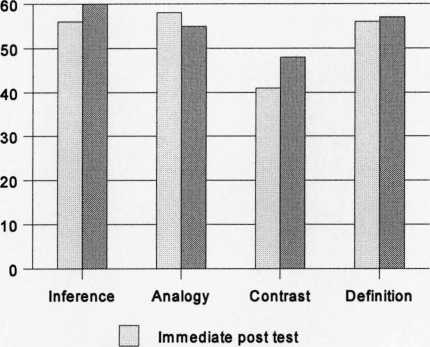Analogy condition performed significantly better than the children in the Lexical contrast
condition (Mann-Whitney, Z=2.09, p<.05). No significant differences were found during the
delayed post test.
Figure 5.12 Total number of correct responses in the definition task by linguistic
condition for both post tests

∏ Delayedposttest
Linguistic condition differences within each age group were also investigated. The same
pattern was found within each age group as before. However, post hoc analysis of the 4 year-
olds responses demonstrated that children in the Analogy condition performed significantly
better than children in the Lexical contrast condition during the delayed post test (Mann-
Whitney: Z=2.00, p<.05). Furthermore, post hoc analysis of the 6 year-olds responses
revealed a trend for the children in the Definition condition to perform better than the
children in the Analogy and Lexical contrast conditions during the immediate post test.
Lastly, children in the Inference condition performed significantly better than children in the
Definition (Mann-Whitney: Z=1.9, p<.05) and Lexical contrast conditions (Mann-Whitney:
Z=2.3, p<.05) during the delayed post test.
To what extent does children ,s success on the definition task change between the immediate
and delayed post test ?
During the immediate post test the children provided 54.9% appropriate definitions while in
the delayed post test they provided 57.3 % appropriate definitions. Statistical comparison
between the two post tests revealed no significant differences. Comparison of children’s
performance between the two post tests within each age group revealed the same pattern.
139
More intriguing information
1. Integration, Regional Specialization and Growth Differentials in EU Acceding Countries: Evidence from Hungary2. Education Research Gender, Education and Development - A Partially Annotated and Selective Bibliography
3. Fortschritte bei der Exportorientierung von Dienstleistungsunternehmen
4. Industrial districts, innovation and I-district effect: territory or industrial specialization?
5. Influence of Mucilage Viscosity On The Globule Structure And Stability Of Certain Starch Emulsions
6. Does Market Concentration Promote or Reduce New Product Introductions? Evidence from US Food Industry
7. Making International Human Rights Protection More Effective: A Rational-Choice Approach to the Effectiveness of Ius Standi Provisions
8. Who is missing from higher education?
9. The Dynamic Cost of the Draft
10. THE UNCERTAIN FUTURE OF THE MEXICAN MARKET FOR U.S. COTTON: IMPACT OF THE ELIMINATION OF TEXTILE AND CLOTHING QUOTAS